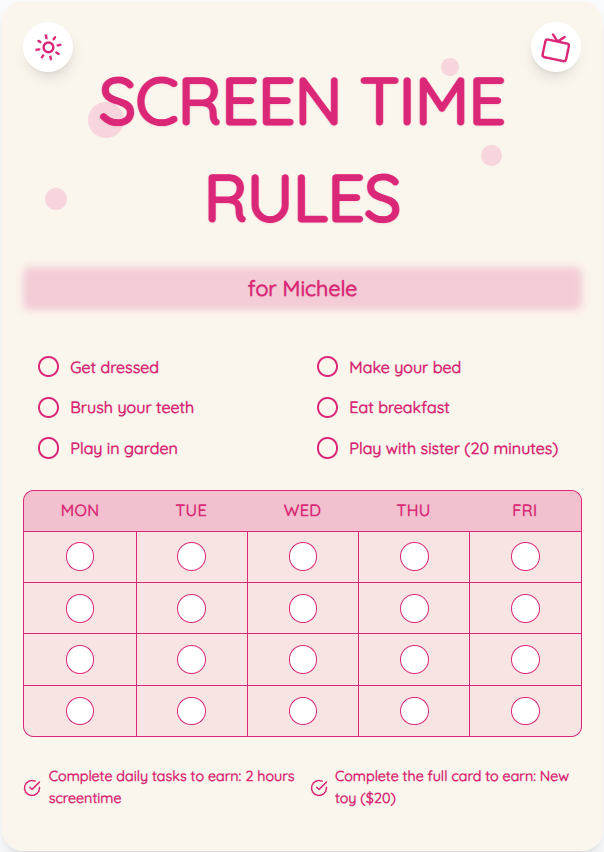Why Ignoring Screen Time Limits Can Impact Your Child's Development
As parents, setting and enforcing screen time limits can be challenging. However, ignoring these limits can have a significant impact on your child's development. In this guide, we'll provide practical tips and solutions to help you navigate the screen time dilemma with ease.
See What Your Screen Time Chart Will Look Like
Here's an example of a beautiful, customizable screen time rules chart you can create for your family

Understanding the Importance of Screen Time Limits
Screen time limits are crucial for children's physical, mental, and emotional well-being. Excessive screen time has been linked to various issues such as sleep disturbances, obesity, and poor academic performance. By setting limits, you can ensure that your child engages in a balanced range of activities for holistic development.
Practical Tips for Implementing Screen Time Rules
1. Use a screen time chart generator like ScreenTimeRules.com to create a visual schedule for your child. 2. Set clear and consistent rules regarding when and how long your child can use screens. 3. Encourage alternative activities such as outdoor play, reading, and creative projects. 4. Be a role model by demonstrating healthy screen habits yourself.
Put These Tips Into Action
Create a custom chart to implement these strategies with your child
Managing Screen Time Challenges and Temptations
It's common for children to push back against screen time limits. Stay firm but flexible in enforcing the rules. Communicate openly with your child about the reasons behind the limits. Offer rewards for adhering to the rules and consequences for excessive screen time use.
Creating a Balanced Screen Time Environment
Limiting screen time doesn't mean banning screens altogether. Focus on quality over quantity by choosing educational and age-appropriate content. Create tech-free zones in your home, such as the dining area or bedrooms. Encourage open discussions about online safety and digital citizenship with your child.
Practical Tips for Success
- Use a screen time chart to visually represent the schedule
- Involve your child in setting screen time limits to promote ownership
- Set specific time slots for different types of screen activities (e.g., educational apps, entertainment)
- Monitor your child's screen time usage through parental control apps
Frequently Asked Questions
How much screen time is appropriate for my child?
The American Academy of Pediatrics recommends no more than 1 hour of high-quality screen time per day for children aged 2-5 and consistent limits for older children.
What are the signs of excessive screen time?
Signs include irritability when screens are taken away, difficulty transitioning from screens to other activities, and neglecting responsibilities due to excessive screen use.
How can I handle screen time negotiations with my child?
Set clear expectations in advance, involve your child in the decision-making process, and be prepared to offer compromises while staying firm on essential limits.
By proactively managing screen time limits and incorporating our practical tips, you can promote healthy screen habits, support your child's development, and enhance family harmony. Visit ScreenTimeRules.com to create personalized screen time charts tailored to your family's needs.
Ready to Transform Your Family's Screen Time?
Join thousands of parents who have successfully managed screen time with our customizable charts.
